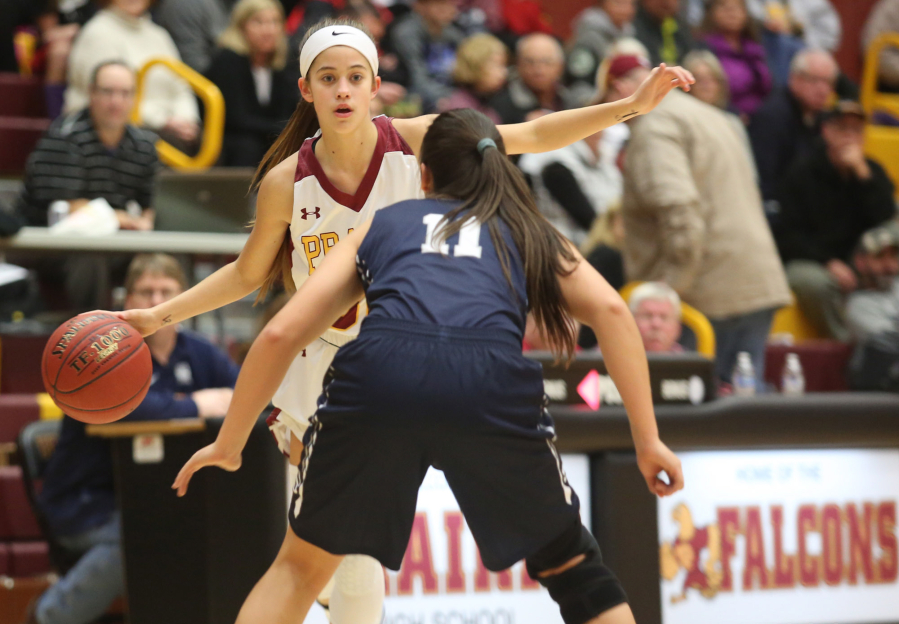The Washington Interscholastic Activities Association released its first RPI rankings for high school basketball on Thursday.
And when the members of the Prairie girls basketball team saw their ranking, they had to be thinking “not again.”
Last season, in the RPI system’s debut, Prairie was one of the teams the system was not kind to.
The Falcons debuted last January at No. 12, then dropped to No. 17 after winning their first two league games.
That’s right – they won, twice, and fell in the rankings.
Prairie never rose much higher the rest of the season and, despite a 20-4 overall record, was seeded 13th into the state tournament.
So you can understand how Prairie’s initial ranking led to some frustrated eye rolls by the Falcons. The unbeaten Falcons were 38th.
Proponents of the RPI would warn everyone to take a breath. The season is early and we should all wait until the end of the season to pass judgment.
But they told us that last year, when Prairie sat at No. 17 and never rose high enough to warrant anything better than a No. 13 seed — much along the line that we predicted.
We aren’t fortune tellers. But we know how the RPI system works and we have a basic understanding of mathematics.
The WIAA made changes to the RPI system to make it work better in its second year. First, they will begin accurately to record win-loss records of out-of-state opponents, which wasn’t being done last season.
That should help the Falcons when they travel to the Bay Area to take part in the West Coast Jamboree.
And this year, postseason games will be factored into the RPI. We won’t know that impact until February.
Both changes are steps in the right direction. But there are still steps to be taken.
Yes, the season is early, and these early-season rankings can change dramatically. In fact, Prairie’s initial 38th ranking got cut in half to No. 19 as the time of this writing. The RPI rankings are very fluid, and change every time a new result is reported.
Flaws in the RPI system can be exaggerated in these early rankings. But they are flaws that will still be there when teams are seeded for state in February. They are just more visible now.
One remaining flaw in the system is that the RPI does not take classification into account. In other words, a win over a Class 4A team (the largest school classification) counts the same as a win over a 1B team (the smallest). And I think we can all agree those two teams are not the same.
It’s not a coincidence that Prairie (5-0), a 3A team, is No. 19 having played four of its five games against 4A teams, while league rival Hudson’s Bay (3-1 according to the RPI) is No. 3 after playing one 2A team and twice against a 1A team.
Now, I’m not saying that every 4A team is better than every 3A team. But I would say the average 4A team is better than the average 3A team. That’s sort of why we have classifications.
Prairie plays many 4A teams in non-league games largely because the closest 3A team not in its league is over 100 miles away.
But the Falcons aren’t getting properly credited for playing larger schools.
And that brings us to the second major flaw in the system — it puts too much stock in the strength of a team’s schedule.
The RPI is made up of three components – a team’s win-loss percentage (WP), the win-loss percentage of its opponents (OWP) and the win-loss percentage of its opponents’ opponents (OOWP).
WP comprises 25 percent of the overall rating, OWP 50 percent and OOWP 25 percent.
So three-fourths of what teams are being rated upon has nothing to do with what the team can control — its own play.
The most important thing a team should get judged on is the performance it can control, and that’s playing the games on its schedule.
If the ratio of RPI were changed from 25-50-25 to a 40-40-20, for example, Prairie’s RPI rating would rise from its current .591 to .673. And that would give the Falcons a more accurate ranking than 19th.
Prairie isn’t the only team adversely impacted by the RPI’s flaws, but the Falcons serve as a good example.
It will be important to watch the Falcons’ spot in the rankings in about two weeks, when they return from the West Coast Jamboree. The teams in their bracket have a cumulative win percentage of .816, which should give Prairie a good boost.
But if the Falcons aren’t in the top eight of the 3A RPI rankings, the coveted spots in the 3A state tournament bracket, they will be hard pressed to move up higher once league play begins as the 3A Greater St. Helens League is not a particularly strong league.
That’s not the Falcons fault. And they shouldn’t be penalized for that.
Tim Martinez is the assistant sports editor/prep editor for The Columbian. He can be reached at (360) 735-4538, tim.martinez@columbian.com or follow his Twitter handle @360TMart.




